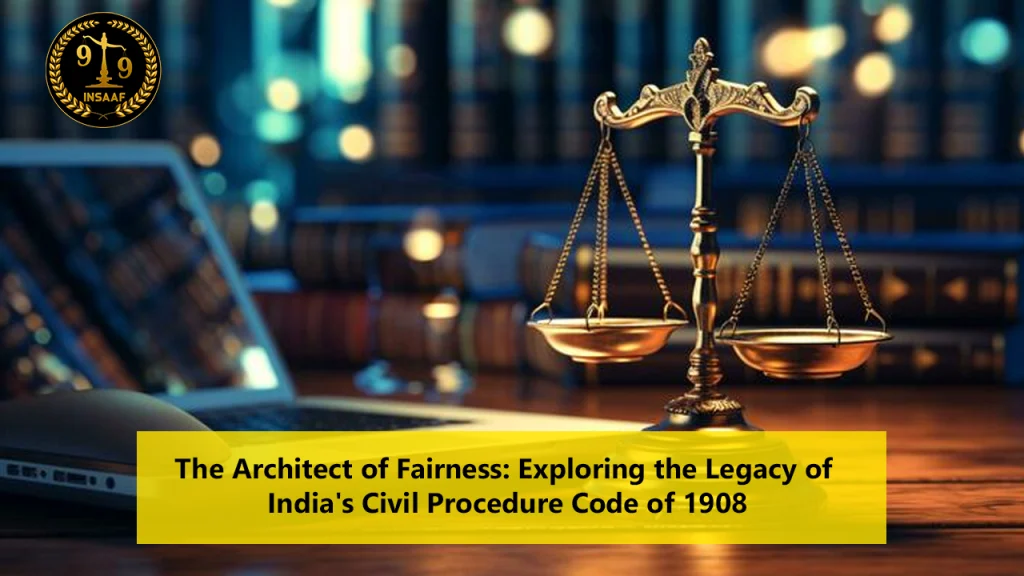

Online Legal Advice from Insaaf99® Online Lawyer Consultation in India


Online Legal Advice from Insaaf99® Online Lawyer Consultation in India

The Civil Procedure Code is a vital part of the Indian legislative framework. It provides provisions to address civil disputes, filing lawsuits and present evidence etc. The Civil Procedure Code also known as C.P.C was enacted under British rule in the year 1859, however, it underwent many amendments before getting re-enacted in 1908. It aims to provide a structured and organized approach to provide resolution for civil disputes. In this article we will explore various provisions and key aspects of Civil Procedure Code.
The history of Civil Procedure Code dates back to the colonial era, in order to streamline the administration of civil cases in Indian code and organized procedural law was needed. The Civil Procedure code was first enacted for this purpose in the year 1859, then it underwent amendments in the years 1860, 1861, 1878, 1879, and 1882 and finally got re-enacted in 1908. However it came into force in the year 1909 and a major revamp to CPC was witnessed in 1976. The procedure code aimed to bring fairness, uniformity and consistency in the adjudication of civil disputes in India. Some of the examples of the Civil disputes it address
The major amendments done in 1976 was:
Also Read: - Unlocking the Key to Corporate Decision-Making: Exploring Quorum in Company Law
The CPC is divided into two primary parts:
Part I (Sections 1-158): The first part contains general principles applicable to most civil proceedings.
Part II (First Schedule): The second part comprises 51 Orders and Rules that provide detailed procedures for specific situations arising during a lawsuit.
Key Provisions of Civil Procedure Code 1908: The CPC provides provision for the civil so let us understand civil suit before we look in the key provisions of this code
The Civil Procedure Code 1908 governs the procedure of filing and conducting civil suits in civil court. Under the civil suit there can be two or more parties involved which are seeking legal remedy to dispute by legal action against the other party.

Plaintiff: The person who institutes a suit is known as a Plaintiff.
Defendant: The person against whom the legal action is taken of the charges were framed is known as defendant.
Written Statement: The written statement for instituting the civil suit for claim in writing showing cause of action is called a plaint and response/reply thereof is known as a Written Statement.
Judgment: The Judgement is passed by a civil judge on the grounds of decree or order.
Decree: After the judgment has been pronounced a decree comes into force, it is a formal expression of the judgment, explaining the rights and obligations of the parties involved.
Execution: Execution of Decrees Order XXI, along with Sections 36 to 74, extensively addresses execution procedures in the Code of Civil Procedure. While the term 'execution' remains undefined, it essentially denotes the enforcement of a court judgment.
Key Provisions: The key provisions under CPC are aimed to provide a streamlined approach to civil suits.
Jurisdiction: The Civil Procedure Code provides details about the jurisdiction of civil courts by categorizing them into territorial ruling and their financial limits. It provides information about the hierarchy of courts and their respective jurisdictions which helps the petitioner to decide and file a case in the correct civil court following the judicial hierarchy.
Institution of Suits: The CPC provides provisions and guidance on how to start a civil suit and it covers aspects such as plaints, pleadings, and written statements. The CPC further provides the rules and guidelines of examining the pleading in order to gain clarity and transparency in the cases where allegations were made against the other party.
Summons and Service: This procedure code also establishes clear guidelines for servicing summons to the defendants. This makes sure the defendant has proper participation in the civil suit against them enabling the way of natural justice and fair treatment.
Trial Procedure: Trial is a very important part of the legal process, under this process both parties meet in the court. The civil procedure code provides detailed guidelines for various aspects of trial. It establishes guidelines for conducting a fair trial, and also provides a procedure of examining and cross examining of the witnesses produced in the court for the dispute and guidelines and procedure for presenting evidence in the court.
Appeals and Review: Appeal and Reviews are very important in the legal process if the person is not satisfied with the previous judgment or they have additional evidence for submission post judgment they exercise their right for appeal and review. For making sure appeal and review are done with complete transparency and fairness, the civil procedure code provides guidelines for facilitating the redressal of grievances. It delineates the procedure of submitting appeal and review petition in the cases in higher court in the case where one the party believes they can get the decision overturned based on new evidence, witness or any missing argument.
Also Read: - The Final Chapter: Understanding the Dynamics of Winding Up of a Company
The CPC plays a vital role as it provides the guidelines for ensuring fair and just treatment to everyone. By laying the procedure codes it aims to bring consistency in the judgment related to civil suits. The structured process provided under this code not only helps in resolving the dispute but also helps in protecting the rights of both plaintiff and defendant. The CPC enforces confidence among litigants by providing a clear blueprint for fair and efficient legal resolution of civil disputes.